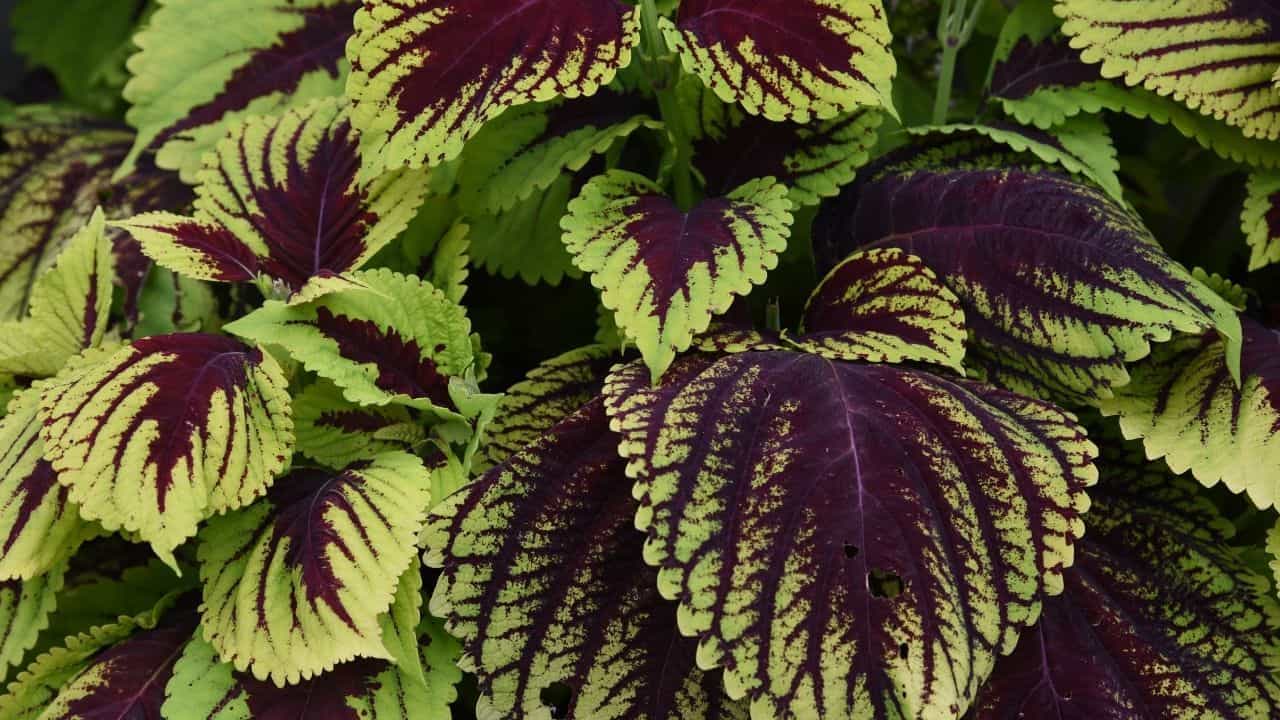To make coleus bushy, provide it with adequate sunlight, prune regularly, and feed it with balanced fertilizer. By following these steps, you can encourage the plant to grow densely and create a bushy appearance.
Coleus plants thrive in bright indirect light and require at least six hours of sunlight each day. Pruning the plant regularly helps to remove any leggy or stretched-out growth, which promotes branching and bushiness. Additionally, using a balanced fertilizer during the growing season can provide the necessary nutrients for lush foliage and compact growth.
These simple practices will help you achieve a bushy and attractive coleus plant.

Credit: plantophiles.com
Increase The Visual Appeal Of Your Coleus Plants
Enhancing the visual appeal of coleus plants can be achieved by making them bushier. By following a few simple steps, you can add depth and dimension to your garden. Pruning the plants regularly helps to promote a fuller growth habit.
Pinching off the tips of the branches will encourage branching and a more compact form. Additionally, removing any yellowing or dead leaves will enhance the overall aesthetics of the plants. Providing adequate sunlight, water, and fertilization will ensure healthy growth and vibrant colors.
Remember to maintain a consistent watering schedule to prevent the plants from becoming leggy or spindly. With these techniques, you can transform your coleus into stunning focal points in your garden.
Optimize The Growth And Health Of Your Coleus Plants
To optimize the growth and health of your coleus plants, it is important to improve air circulation. By doing so, you can reduce the risk of disease and pests. Adequate air flow helps to prevent fungal and bacterial infections, which can lead to the decline of your coleus.
One way to improve air circulation is by spacing out your plants, allowing for proper airflow between them. Additionally, you can trim back any overcrowded branches or foliage, promoting air movement through the plant. Regularly removing dead or decaying leaves can also help prevent the spread of diseases.
Lastly, consider placing your coleus in a location with good ventilation, away from any obstructions or tight spaces. By optimizing air circulation, you can ensure that your coleus remains bushy and vibrant throughout the growing season.
How to Make Coleus Bushy: Step by Step Guide
Identification Of Coleus Plant Varieties
Coleus plants come in various varieties, making it important to identify them accurately. When distinguishing between upright and bushy types, specific characteristics come into play. To recognize a bushy coleus plant, observe its growth pattern, foliage density, and compact structure.
Bushy varieties tend to have plentiful leaves tightly arranged together, creating a dense and full appearance. These plants often have a more compact form compared to their upright counterparts. By understanding these distinctions, you can ensure that you are correctly identifying and cultivating bushy coleus plants.
So, keep an eye out for these characteristics and enjoy the beauty and lushness they bring to your garden or indoor space.
Factors Affecting The Bushiness Of Coleus Plants
Factors such as light requirements, soil conditions, nutrient levels, and watering techniques play a crucial role in determining the bushiness of coleus plants. Adequate sunlight is essential for their growth and overall appearance. Coleus plants prefer well-draining soil that is rich in organic matter.
Maintaining the right nutrient balance, including a balanced fertilizer, is necessary to promote the plant’s bushiness. Proper watering techniques, such as providing sufficient moisture without overwatering or allowing the soil to dry out completely, are vital for the health and fullness of coleus plants.
By considering these factors and providing optimal conditions, you can ensure that your coleus plants develop into beautiful, bushy specimens.
Pruning And Pinching
Regular pruning is essential for making your Coleus bushy. By pruning, you can promote branching and bushiness. Proper tools and techniques play a vital role in achieving the desired results. Pruning helps to remove leggy growth and encourages the plant to grow more compactly.
It also helps in maintaining the plant’s shape and overall health. Regular pruning prevents the plant from becoming straggly and encourages the growth of new foliage. It also improves air circulation, reducing the risk of diseases and pest infestation. By pinching off the tips of young plants, you can stimulate lateral growth and create a fuller, more bushy appearance.
Pruning should be done consistently to maintain the desired shape and compactness of the Coleus plant.
Fertilizing For Bushiness
Proper fertilization is essential for achieving a bushy coleus plant. To identify the best fertilizer, consider factors such as the nutrient content, the plant’s specific needs, and the overall health of the soil. Look for a fertilizer with a balanced ratio of nitrogen, phosphorus, and potassium to encourage foliage growth.
Organic options like compost or well-rotted manure can also provide a steady release of nutrients. Apply the fertilizer according to the instructions, avoiding over-fertilization which can harm the plant. Regularly monitor the growth and health of the coleus, making adjustments to the fertilization routine if necessary.
By following these guidelines, you can ensure that your coleus plant thrives and becomes beautifully bushy.
Watering For Bushiness
Proper watering is key to achieving bushiness in your coleus plants. The watering schedule for bushy coleus plants should follow a balanced approach. Water your plants thoroughly, allowing the soil to become moist but not overly saturated. Avoid overwatering, as this can lead to root rot and hinder bushiness.
On the other hand, underwatering can cause wilting and stunted growth. It is important to strike a balance by monitoring the moisture levels in the soil. Feel the top inch of the soil with your finger and water when it starts to feel dry.
Be mindful of the weather conditions and adjust the watering frequency accordingly. Additionally, it’s crucial to water at the base of the plant to prevent foliage diseases. Following these watering techniques will help you nurture bushy and vibrant coleus plants.
Pests And Diseases Affecting The Bushiness Of Coleus Plants
Pests and diseases, both can affect the bushiness of coleus plants. Prevention and control measures are crucial to tackle common pests and identify and treat prevalent diseases. Regular inspections and prompt action help in preventing pest infestations. Keep an eye out for aphids, thrips, and spider mites, which are common pests affecting coleus plants.
Introducing beneficial insects, such as ladybugs, can help control these pests naturally. Neem oil and insecticidal soaps can also be used. Diseases like powdery mildew and fungal rot can hinder the bushiness of coleus plants. Adequate spacing between plants, good air circulation, and proper watering practices are key in disease prevention.
Using fungicides can help control existing diseases. By implementing preventive measures and promptly addressing pests and diseases, you can ensure your coleus plants remain bushy and healthy.
Leaf Discoloration And Wilting
Leaf discoloration and wilting are common issues that can affect the health of your Coleus plants. There are several causes behind these problems. One of the main culprits is overwatering, which can lead to root rot and deprive the leaves of necessary nutrients.
Inadequate lighting or exposure to direct sunlight can also cause the leaves to turn yellow or brown. Pests, such as aphids or spider mites, can further contribute to leaf discoloration and wilting. To prevent and address these issues, it is important to maintain proper watering practices, ensuring that the soil is well-drained.
Providing adequate lighting, either through natural sunlight or grow lights, is also crucial. Regularly inspecting your plants for pests and treating them accordingly can help maintain the health and vibrancy of your Coleus bushy.
Legginess And Sparseness
Leggy and sparse growth in coleus plants can be caused by insufficient sunlight or crowded spacing. To prevent this, ensure your coleus receives at least six hours of direct sunlight daily and provide enough space for proper air circulation. Using well-draining soil and regular watering will also aid in promoting compactness and fullness.
Additionally, pinching off the tips of your coleus stems will encourage branching and create a bushier appearance. Regularly removing any dying or yellowing leaves will further enhance the plant’s overall appearance. By following these techniques, you’ll be able to maintain a healthy and bushy coleus plant that will add vibrancy to your garden or indoor space.
Choosing Suitable Companion Plants
Choosing suitable companion plants is crucial for making coleus bushy. Plants that complement the growth habits of coleus can help enhance its overall appearance. Additionally, these companion plants provide additional benefits to coleus, such as improved pest resistance or increased nutrient absorption.
By carefully selecting companion plants that have similar light and water requirements, you can create a harmonious and thriving garden ecosystem. Some excellent choices include marigolds, petunias, and impatiens, as they not only complement the vibrant colors of coleus but also help deter pests like aphids and whiteflies.
Furthermore, planting herbs like basil or lavender near coleus can attract beneficial insects, ensuring a healthier and more robust coleus bush. So, consider these companion plants when looking to make your coleus bushy and create a visually appealing and beneficial garden setting.
Proper Arrangement And Spacing
Proper arrangement and spacing are crucial factors in making a coleus bushy. When arranging companion plants, consider their visual effect to enhance the overall appeal. Remember to determine the ideal spacing that promotes optimal growth. By following these guidelines, you’ll achieve the desired outcome for your coleus plants.
Frequently Asked Questions For How To Make Coleus Bushy
How Do You Prune Coleus To Make It Bushy?
Prune coleus to make it bushy by cutting off the top growth regularly. Trim above a set of leaves to encourage branching and remove flowers to redirect energy to foliage.
How Do You Thicken Coleus Plants?
To thicken coleus plants, pinch off the tips of new growth regularly. This will encourage bushier, fuller growth.
Why Do Coleus Get Leggy?
Coleus plants tend to become leggy due to insufficient light, pushing them to grow long, weak stems.
Why Is My Coleus Thinning Out?
Coleus plants can thin out due to insufficient sunlight, overwatering, or lack of nutrients. Prune and provide proper care to restore its vitality.
Conclusion
To summarize, making your coleus bushy is achievable by following a few simple steps. By pinching off the growing tips, you encourage lateral growth and fuller foliage. Regularly trimming away leggy and unfurled stems helps redirect the plant’s energy towards producing bushier growth.
Providing adequate sunlight, preferably a mix of direct and indirect light, promotes strong, compact growth. Adequate water and well-draining soil are essential, preventing root rot and enabling healthy growth. Fertilizing your coleus with balanced, slow-release fertilizer ensures it receives the necessary nutrients to promote bushiness.
Furthermore, regularly checking for pests and diseases and promptly addressing any issues will help maintain the overall health of your coleus. By implementing these techniques, you can enjoy a flourishing, bushy coleus that adds vibrancy and beauty to your indoor or outdoor space.

